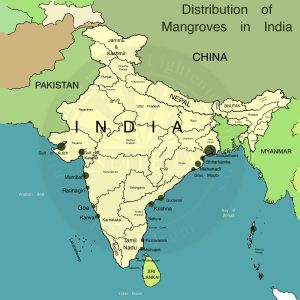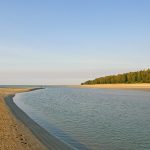What is it?
- Mangroves are small trees and shrubs which grow along the coastlines.
- These trees thrive in salty water and form unique forests on the edge of land and the sea.
- They also grow in swamps.
- Mangrove forests can survive extreme weather conditions and require low oxygen levels.
- India’s contribution is 45.8% total mangrove cover in South Asia.
- According to the India State of Forest Report, 2019, the mangrove cover in India is 4,975 sq km, which is 15% of the country’s total geographical area.
- West Bengal has the highest percentage of area under total Mangrove cover followed by Gujarat and Andaman Nicobar Islands.
Types of Mangroves
- Red Mangroves (Rhizophora spp.): Known for their distinctive stilt roots, which provide stability and access to oxygen in waterlogged soils.
- Black Mangroves (Avicennia spp.): Identified by their pneumatophores, which are vertical roots that stick out of the soil to help with gas exchange.
- White Mangroves (Laguncularia racemosa): Typically found higher up the shore and have a less specialized root system.
- Buttonwood Mangroves (Conocarpus erectus): Often found on the edges of mangrove forests and have a more shrub-like appearance.
Threats to Mangroves
- Coastal Development: Urbanization, industrialization, and infrastructure projects often lead to the destruction of mangrove habitats.
- Pollution: Runoff containing pesticides, heavy metals, and other pollutants can degrade mangrove ecosystems.
- Aquaculture: Expansion of shrimp farming and other aquaculture practices can result in significant mangrove loss.
- Climate Change: Rising sea levels, increasing temperatures, and changing precipitation patterns pose significant risks to mangrove ecosystems.



